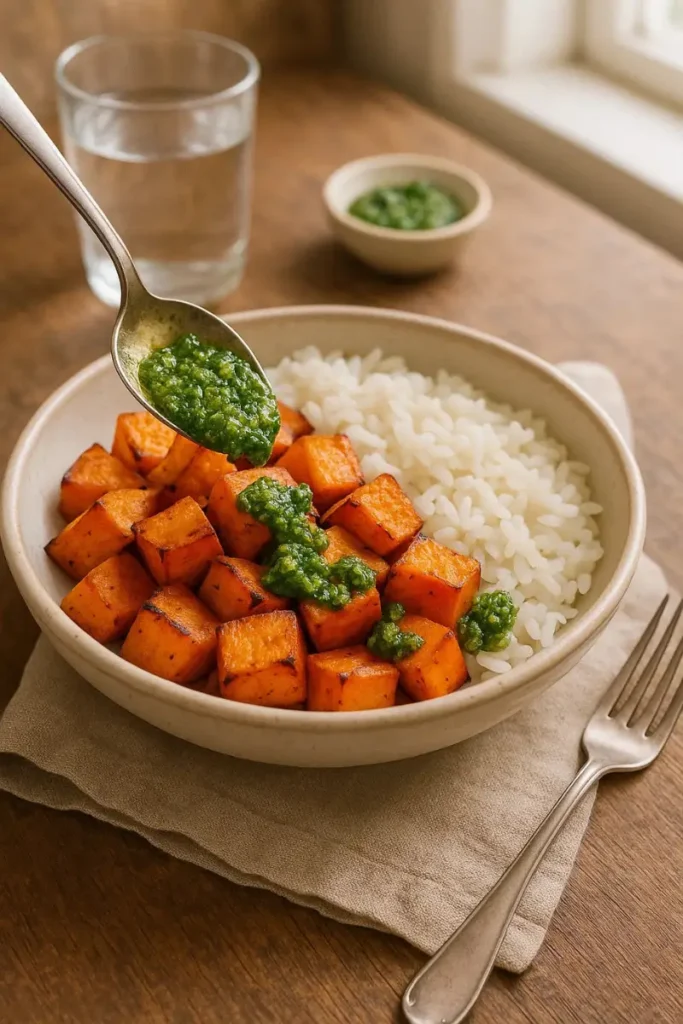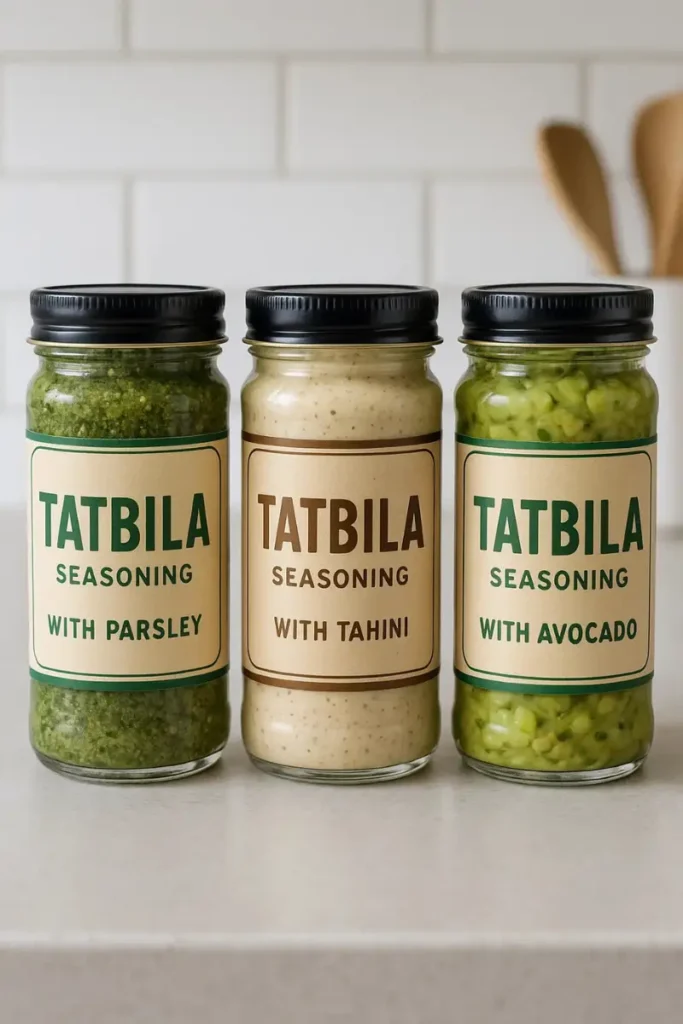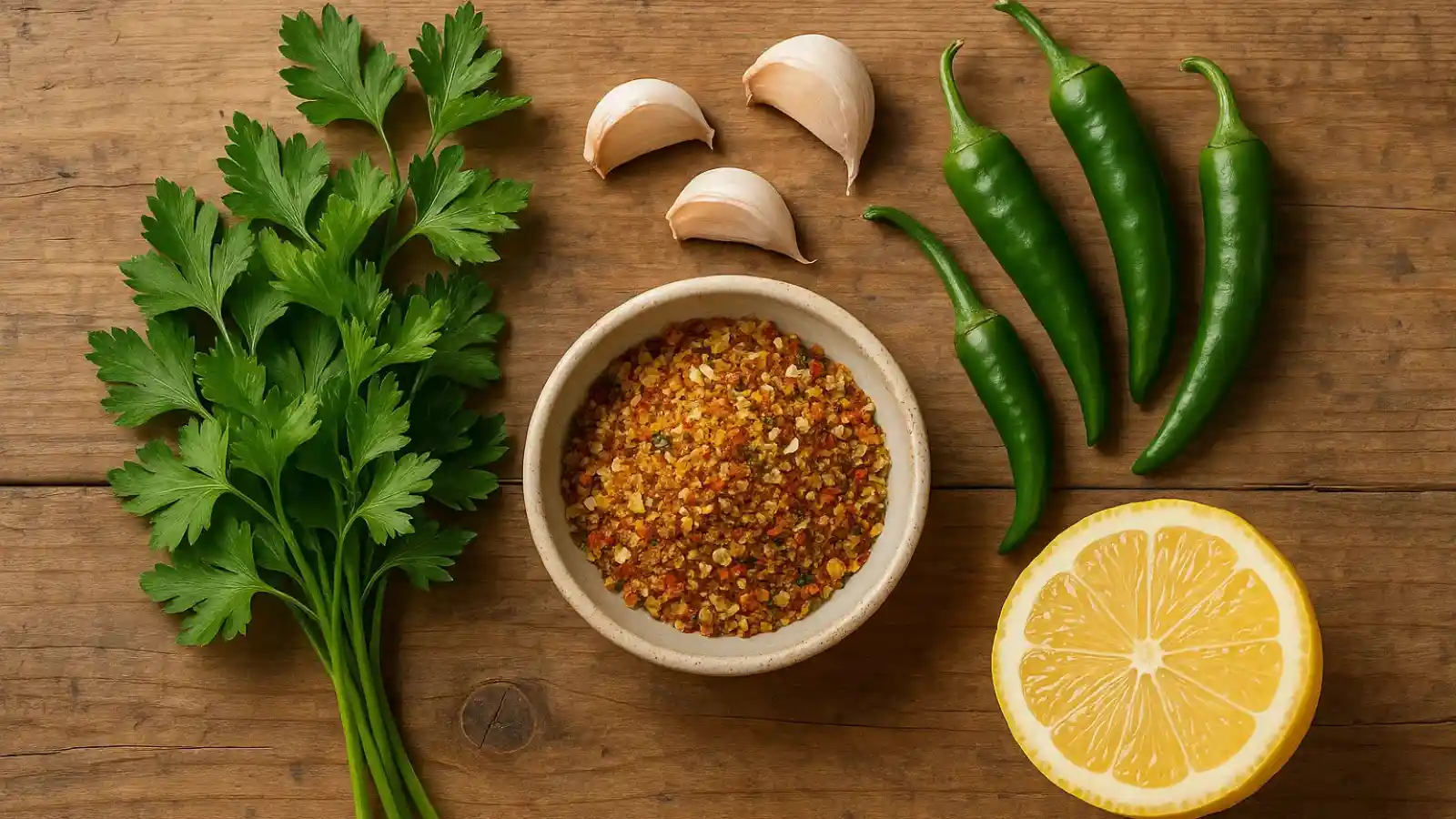Tatbila seasoning was an accident. I was prepping the ingredients for my usual Tatbila sauce recipe—parsley, garlic, chili, lemon—and paused before blending. I took a pinch of the raw mix and tossed it on warm chickpeas. Game-changer. It didn’t need the blender. Just bold, chopped freshness hitting hot food. That’s when I realized Tatbila seasoning could live its own life outside the sauce. It’s vibrant, spicy, and flexible enough to show up in more than just dips. From marinades to grain bowls, this herby base is now a kitchen habit. Let’s talk about how to actually use it—everywhere.
Table of Contents
Tatbila Seasoning Changed Everything: How I Discovered Its Magic
The green flavor bomb that didn’t need a blender
It started the way a lot of my recipes do—messily. I was halfway through making my usual Tatbila sauce, and for whatever reason, I stopped before blending. Maybe I was hungry. Maybe I just wanted to taste what parsley, garlic, lemon, and chili did on their own.
So I spooned the mix—still rough, still chunky—over some warm rice and leftover grilled zucchini. It hit hard. Sharp, fresh, salty, alive. That moment was my introduction to Tatbila seasoning as more than just the pre-step to a sauce. It was a seasoning in its own right.
The day I used Tatbila raw—and it changed everything
There was no heat, no cooking, no rules. Just that raw brightness melting into hot food. Since then, I’ve used Tatbila seasoning as a marinade starter, tossed it over eggs, and even added it to plain yogurt for a lazy dip. You don’t need to blend it. You don’t even need a recipe. Just a rough chop of bold herbs and a little trust in your taste buds.
I realized Tatbila seasoning isn’t a byproduct of the sauce—it’s the soul of it.

What Is Tatbila Seasoning?
When I stopped blending—and started paying attention
I’ve always made Tatbila as a sauce. Parsley, garlic, lemon, green chili… all blitzed together until smooth. It’s been my go-to for falafel and rice bowls for years.
But once, mid-recipe, I got distracted. I had everything chopped and ready—but never plugged in the blender. Instead, I tasted the rough mix. And wow. Bright. Raw. Spicy in a way that sauce never is. That was the first time I used Tatbila seasoning instead of the sauce—and I haven’t stopped since.
Tatbila seasoning is the flavor—just louder
Here’s how I see it:
| Tatbila Seasoning | Tatbila Sauce |
|---|---|
| Chopped, not blended | Smooth and blended |
| Stronger bite, fresh edge | Softer, more balanced |
| No oil, unless you want it | Always has olive oil |
Seasoning is what happens when you leave the ingredients raw and let them speak for themselves. It’s bold. And if you’ve ever enjoyed a spoonful of something like Boom Boom sauce, you know what I mean—layers of flavor that kind of sneak up on you. But this is brighter. Cleaner.
Sometimes I mash the chopped mix into labneh or even stir it into gluten-free soy sauce. Sounds odd, I know. But on rice? It’s wild. And it works.
Honestly, Tatbila seasoning feels more like a cooking instinct now than a recipe.
5 Bold Ways I Actually Use Tatbila Seasoning
It’s not just a falafel thing
The funny thing is, I almost never use Tatbila seasoning the same way twice. It started as a sauce shortcut. Now it’s a habit. A spoonful here, a sprinkle there—suddenly everything tastes like I meant to cook.
So here are five ways I’ve used it this week (really):
1. Over roasted veggies
After pulling hot sweet potatoes or carrots from the oven, I just scatter a spoonful on top. The heat wakes up the garlic and chili, and everything smells better. Way better.
2. In egg salad
Sounds weird, works wonders. A chopped boiled egg, a scoop of mayo, and a little Tatbila seasoning. Tangy, spicy, fresh. Nothing like deli egg salad. In a good way.
3. Yogurt swirl dip
One day I had some Big Mac sauce left and wanted to mix things up. I stirred Tatbila seasoning into plain yogurt instead. More herb-forward. Less heavy. Even better with pita chips.
4. Marinated tofu or chicken
Just mix it with olive oil or yogurt and let it sit for 20 minutes. I’ve grilled tofu like that and even seared shrimp. The raw mix clings better than sauce.
5. Spoon-over moment
Leftover rice? Cold lentils? That “what-am-I-eating” moment? Drop some Tatbila seasoning on top. I’ve even drizzled it with a little Mango Habanero Sauce to add heat and sweetness at once. Totally unplanned. Totally delicious.
What I love most about Tatbila seasoning is that it’s forgiving. You don’t need perfect measurements or timing. Just good ingredients and a little curiosity.
How I Store Tatbila Seasoning—and the Little Tweaks I Swear By
It doesn’t last long in my fridge, but not because it spoils
I keep Tatbila seasoning in a small jar, unblended, covered tight. It’s best in the first 2–3 days. By day four, the garlic starts mellowing out and the herbs go a little soft—but it’s still fine to use. Sometimes I even mash it into hummus when it’s past its peak. Adds new life.
If I’ve got extra, I press it flat in a zip bag and freeze it. Break off a chunk later and drop it into warm rice or broth. Just like that, dinner’s got flavor again.
Some days I follow the rules. Some days I add avocado.
Not every batch is the same, and that’s kind of the point. One version might lean parsley-heavy. The next, all garlic. Here are a few things I’ve tried that turned out great:

- Cilantro instead of parsley: works especially well when I’m pairing it with grilled meat or smoky dishes.
- A pinch of cumin: makes it warmer, deeper. Especially good on chickpeas.
- Tahini swirl: takes it in a creamy direction. Less bite, more body.
- Avocado: yeah, once I had one going soft. Mashed it in. Made it rich like Alabama White Sauce but greener, brighter.
Sometimes I even pair it with Cajun Cream Sauce if I’m making wraps—like heat and cool playing together.
The beauty of Tatbila seasoning is it’s not fixed. It’s alive. You make it with what you have, taste as you go, and tweak it based on the moment.
FAQs
What is in Tatbila sauce?
The classic Tatbila sauce starts with fresh parsley, garlic, lemon juice, green chili, and salt. Olive oil is usually added during blending to smooth it out. Before blending, that raw herb mix is what I call Tatbila seasoning—and it’s just as useful on its own.
How to make béchamel sauce?
Start by melting butter, then whisk in flour to make a roux. Gradually add warm milk while whisking until it thickens into a creamy sauce. A touch of salt and nutmeg finishes it. Béchamel is smooth and comforting—basically the opposite of the bold, raw bite of Tatbila seasoning, but I keep both in rotation.
What is Tulum sauce?
Tulum sauce is typically creamy and spicy with a citrus kick. It’s often mayo-based with lime juice, garlic, and chili. Think of it as the cousin of Tatbila seasoning—less herb-forward, more rich and tangy. It’s amazing on tacos or grilled corn.
How to make Idaho sauce?
Idaho sauce is usually a potato-lover’s dream—mayo or sour cream mixed with garlic, mustard, vinegar, and herbs like dill or chives. It’s thick, tangy, and made to be scooped with fries. Not as bright as Tatbila seasoning, but just as quick to mix from pantry basics.
Conclusion
Tatbila seasoning wasn’t supposed to be anything big. I was just messing around—halfway through making sauce, didn’t feel like plugging in the blender. So I tasted it as-is. Bright. Bold. A little too garlicky. I liked it.
Since then, it’s kind of stuck. Some days I make it just for eggs. Other times, I forget it in the back of the fridge and remember it right when I need something to wake up a plate. It’s messy, quick, and honestly better when it’s not too thought out.
That’s the point, right? Make it your way. Don’t wait for perfect.

